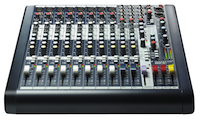

Soundcraft MFXi8/2 Mixer
Jul 8, 2011 10:33 AM,
by John McJunkin
A sophisticated mixer for a variety of simple applications.
Soundcraft MFXi8/2 Mixer
There are applications that require dozens of inputs, sophisticated signal routing, parametric equalization, mute groups, and maybe even automation. For those applications, there are high-end, expensive mixers. Then there are very simple applications that only require a small handful of inputs to blend a few mics and maybe a CD player or iPod. Despite the fact that a small mixer is called for, modern technology still gives us some nice features that allow us to go well beyond the simple blending of signals for public address, including good quality digital signal processing. Additionally, there’s no point in specifying a large, heavy mixer when a small, lightweight unit will do. To this end, Soundcraft offers its MFXi series of consoles. I requested an MFXi8/2 for evaluation, deliberately choosing the smallest of these so as to be able to present information for the benefit of professionals who are either on a budget or have their large-frame console needs currently met and need a compact but advanced mixer for certain applications.
The MFXi8/2 has eight mono inputs with XLR and TRS balanced inputs for mic and line, respectively. The line input also accepts unbalanced signals. A TRS insert point is also found on each channel, along with a gain knob and 100Hz high-pass filter. Next in the path is the equalizer, with high and low shelving fixed at 12kHz and 80Hz, respectively, and mids sweepable between 150Hz and 3.5kHz with a Q of 1.5. All three bands facilitate boost or cut of 15dB. Following EQ in the signal path are the mixer’s auxiliaries. Auxes 1 and 2 feed physical TRS output jacks on the mixer, while aux 3 (known on this mixer as “FX”) feeds the internal Lexicon 24-bit digital effects processor. Each channel also features a pan knob, mute button, prefader listen button, and a bus-routing button that determines whether the channel’s output feeds the stereo “mix” bus or the “sub-L/sub-R” buses. A green “signal present” and red peak LED help to indicate input level on each channel. In addition to the eight mono channels, the mixer also offers two stereo line inputs. They’re virtually identical to the mono inputs, but they lack sweepable mids in the EQ section (mids are fixed at 720Hz). They also lack continuously variable input gain control, inserts, and the 100Hz HPF that the mono channels have. The stereo input controls are otherwise identical with the notable exception that a balance knob replaces the pan knob of the mono inputs.
Beyond the 10 short-throw faders that control levels of the mixer’s input channels, there are four additional faders: one for effects return level, one each for sub-L and sub-R, and a single stereo “mix” bus fader. The effects return channel features a prefader listen button, a pleasantly surprising feature on a mixer of this size and price. Ten-segment stereo LED meters show levels for both the main output and also pre- and after-fader listen solos. Buttons in this master section determine whether the sub buses are routed to the main stereo mix, and if so, whether they’re presented in mono or stereo. The mixer also offers balanced TRS monitor outputs, and there is a level control and a button to determine whether three auxes have master level knobs and after-fader listen buttons, and aux 2 can be assigned globally as pre- or post-fader. A headphone jack with a level control knob is also featured, as is a stereo RCA two-track input with a level control and buttons to route it to the main mix, to the monitors, or both. There is also a stereo aux return with a level knob represented by two balanced TRS jacks. Of course, there are balanced TRS outputs for auxes 1 and 2, along with the two sub buses, the FX bus, and a mono output. The mixer’s main output is a pair of balanced XLR jacks. There is a stereo pair of RCA “record out” jacks to facilitate recording, and a single button to globally apply 48V of phantom power to the mic inputs.
The internal Lexicon digital effects processor offers a nice array of parametric controls, including knobs that adjust various parameters depending upon the type of effect selected. One handles predelay/time/speed, while a second determines decay/feedback/depth, and a third is deemed the variation knob, controlling “liveliness” or diffusion depending on the selected reverb. A rotary switch determines which of 16 effects in each of two banks is selected, for a total of 32. A bank switch is not necessary, due to the clever convention facilitated by the rotary switch; each successive rotation of the knob changes from one bank to the other. Two additional knobs allow effects to be routed to auxes 1 and 2 in order to present effects in monitor mixes. An additional TRS jack allows for connection of a foot pedal to mute effects, and there is a handy pushbutton above the effects return fader that does the same. Buttons allow for entry of tempo by tapping and storage of effect programs once parameters are dialed in to suit the mixer.
The GB30 mic pres in the mixer sound good—not as good as those in the sophisticated consoles we mentioned earlier, but they are quiet and undistorted and do the job nicely. The EQs are musical and effective with their ±15dB boost/cut, particularly considering the sweepable mids. While it would be nice to have more than three auxes, it must be remembered that both the 8- and 12-input versions of this mixer are rackmountable, and small mixers like this just aren’t going to deliver that many auxes. What’s great is that the three auxes in this mixer are planned with a lot of forethought. It’s nice that one can be switched pre- or post-fader, and it makes perfectly good sense that one is committed to the internal processor. The remaining two could be devoted to monitor mixes, or just as easily to a couple of additional outboard processors, although three distinct processors on a mixer of this size would almost certainly be overkill; auxes 1 and 2 are obviously intended for monitor mixes in most applications.
Soundcraft MFXi8/2 Mixer
Jul 8, 2011 10:33 AM,
by John McJunkin
A sophisticated mixer for a variety of simple applications.
The overall specs on the console are great—low noise and low distortion. The three-bus routing scheme provides a lot of flexibility, another pleasantly surprising feature in such a small mixer. The 24-bit Lexicon effects sound great too, adding even more value to the mixer, as does the standard Kensington lock slot on the rear of the console, enabling the mixer to be secured in an environment where theft is a concern.
I would feel very confident using this mixer for virtually any AV, meeting, house of worship, theatrical, or corporate setting. If the application doesn’t require dozens of inputs, this mixer still provides a lot of the sophistication that is normally found in larger consoles—definitely worth a look.
John McJunkin is the principal of Avalon Podcasting in Chandler, Ariz. He has consulted in the development of studios and installations and provides high-quality podcast production services.
Product Summary
- Company: Soundcraft
www.soundcraft.com - Product: MFXi series console
- Pros: Flexible signal routing, quality effects, small footprint
- Cons: One more aux would be nice, stereo input EQ mids not sweepable
- Applications: House of worship, music venues, musicians/bands, theater, corporate
- Price: $599
Specifications
- Frequency Response:±1.5dB, 20Hz-20kHz
- THD: Mic sensitivity -30dBu, +14dBu @ mix output: < 0.01% @ 1kHz
Noise
- Mic Input EIN (maximum gain): -126.5dBu (150Ω source)
- Aux, mix and masters (@ 0dB, faders down): < -85dBu
- Crosstalk: (@ 1kHz)
- Channel Mute: > 96dB
- Aux Send Pots Offness: > 86dB
- Power Consumption: Less than 40W
Operating Conditions
- Temperature: 5°C to +40°C
- Input & Output Levels
- Mic Input:+15dBu max.
- Line Input: +30dBu max.
- Stereo Input: +30dBu max.
- Mix Output: +20dBu max.
- Headphones: (@150Ω) 300mW
Input & Output Impedances
- Mic Input: 2kΩ
- Line Input: 10kΩ
- Stereo Input: 45kΩ
- Outputs: 150kΩ (balanced)
5Ω (unbalanced)










